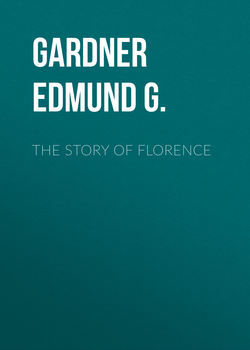The Story of Florence

Реклама. ООО «ЛитРес», ИНН: 7719571260.
Оглавление
Gardner Edmund G.. The Story of Florence
PREFACE
CHAPTER I. The People and Commune of Florence
CHAPTER II. The Times of Dante and Boccaccio
CHAPTER III. The Medici and the Quattrocento
CHAPTER IV. From Fra Girolamo to Duke Cosimo
CHAPTER V. The Palazzo Vecchio–The Piazza della Signoria–The Uffizi
The Uffizi
Ritratti dei Pittori–Primo Corridore
Tribuna
Scuola Toscana
Sala di maestri diversi Italiani
Scuola Veneta
Sala di Lorenzo Monaco
CHAPTER VI. Or San Michele and the Sesto di San Piero
CHAPTER VII. From the Bargello past Santa Croce
CHAPTER VIII. The Baptistery, the Campanile, and the Duomo
CHAPTER IX. The Palazzo Riccardi–San Lorenzo. San Marco
CHAPTER X. The Accademia delle Belle Arti–The Santissima Annunziata–And other Buildings
CHAPTER XI. The Bridges–The Quarter of Santa Maria Novella
CHAPTER XII. Across the Arno
In the Sala dell' Iliade
In the Sala di Saturno
In the Sala di Giove
In the Sala di Marte
In the Sala di Apollo and Sala di Venere
The Sala dell' Educazione di Giove and following rooms
CHAPTER XIII. Conclusion
TABLE OF THE MEDICI
Отрывок из книги
BEFORE the imagination of a thirteenth century poet, one of the sweetest singers of the dolce stil novo, there rose a phantasy of a transfigured city, transformed into a capital of Fairyland, with his lady and himself as fairy queen and king:
But is not the reality even more beautiful than the dreamland Florence of Lapo Gianni's fancy? We stand on the heights of San Miniato, either in front of the Basilica itself or lower down in the Piazzale Michelangelo. Below us, on either bank of the silvery Arno, lies outstretched Dante's "most famous and most beauteous daughter of Rome," once the Queen of Etruria and centre of the most wonderful culture that the world has known since Athens, later the first capital of United Italy, and still, though shorn of much of her former splendour and beauty, one of the loveliest cities of Christendom. Opposite to us, to the north, rises the hill upon which stands Etruscan Fiesole, from which the people of Florence originally came: "that ungrateful and malignant people," Dante once called them, "who of old came down from Fiesole." Behind us stand the fortifications which mark the death of the Republic, thrown up or at least strengthened by Michelangelo in the city's last agony, when she barred her gates and defied the united power of Pope and Emperor to take the State that had once chosen Christ for her king.
.....
With the advent of Charlemagne and the restoration of the Empire, brighter days commenced for Florence,–so much so that the story ran that he had renewed the work of Julius Caesar and founded the city again. In 786 he wintered here with his court on his third visit to Rome; and, according to legend, he was here again in great wealth and pomp in 805, and founded the Church of Santissimi Apostoli–the oldest existing Florentine building after the Baptistery. Upon its façade you may still read a pompous inscription concerning the Emperor's reception in Florence, and how the Church was consecrated by Archbishop Turpin in the presence of Oliver and Roland, the Paladins! Florence was becoming a power in Tuscany, or at least beginning to see more of Popes and Emperors. The Ottos stayed within her walls on their way to be crowned at Rome; Popes, flying from their rebellious subjects, found shelter here. In 1055 Victor II. held a council in Florence. Beautiful Romanesque churches began to rise–notably the SS. Apostoli and San Miniato, both probably dating from the eleventh century. Great churchmen appeared among her sons, as San Giovanni Gualberto–the "merciful knight" of Burne-Jones' unforgettable picture–the reformer of the Benedictines and the founder of Vallombrosa. The early reformers, while Hildebrand was still "Archdeacon of the Roman Church," were specially active in Florence; and one of them, known as Peter Igneus, in 1068 endured the ordeal of fire and is said to have passed unhurt through the flames, to convict the Bishop of Florence of simony. This, with other matters relating to the times of Giovanni Gualberto and the struggles of the reformers of the clergy, you may see in the Bargello in a series of noteworthy marble bas-reliefs (terribly damaged, it is true), from the hand of Benedetto da Rovezzano.
Although we already begin to hear of the "Florentine people" and the "Florentine citizens," Florence was at this time subject to the Margraves of Tuscany. One of them, Hugh the Great, who is said to have acted as vicar of the Emperor Otto III., and who died at the beginning of the eleventh century, lies buried in the Badia which had been founded by his mother, the Countess Willa, in 978. His tomb, one of the most noteworthy monuments of the fifteenth century, by Mino da Fiesole, may still be seen, near Filippino Lippi's Vision of St Bernard.
.....